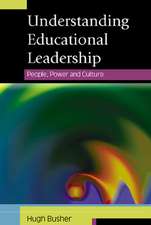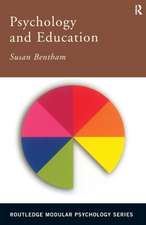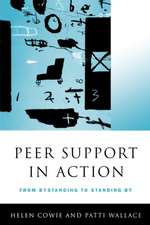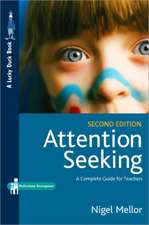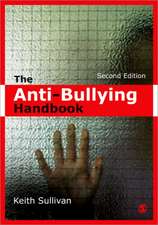Igniting Student Potential: Teaching With the Brain's Natural Learning Process
Autor Angus M. Gunn, Robert W. Richburg, Rita Smilksteinen Limba Engleză Paperback – 13 feb 2007
'A wonderful guidebook for people moving toward constructivism and for many who are already there'
Geoffrey Caine, Director, Caine Learning
'Fosters a refreshing educational discourse of possibility and offers some very useful classroom strategies that work with today's youth'
Peter P. Grimmett, Director, Institute for Studies in Teacher Education, Simon Fraser University
Kindle students' excitement for learning with transformative, field-tested strategies and lessons!
Students are natural thinkers and pattern-seekers who are born to learn. Tapping into their innate abilities is the key to engaging students in their own learning. This innovative guide helps teachers maximize student engagement and achievement by combining brain research, classroom applications, and teaching skills based on the Natural Human Learning Process (NHLP).
Ideal for preservice and inservice teacher training and professional development, this superb resource covers:
- Working with diverse learners from PreK through high school and beyond
- Curriculum applications and sample lessons across content areas, teaching methods, and learning styles
- Research and theory, instructional planning and strategies, assessment, teaching for transfer, and more.
Preț: 305.38 lei
Nou
Puncte Express: 458
Preț estimativ în valută:
58.43€ • 61.17$ • 48.35£
58.43€ • 61.17$ • 48.35£
Carte tipărită la comandă
Livrare economică 05-19 aprilie
Preluare comenzi: 021 569.72.76
Specificații
ISBN-13: 9781412917063
ISBN-10: 1412917069
Pagini: 232
Dimensiuni: 178 x 254 x 12 mm
Greutate: 0.51 kg
Ediția:New.
Editura: SAGE Publications
Colecția Corwin
Locul publicării:Thousand Oaks, United States
ISBN-10: 1412917069
Pagini: 232
Dimensiuni: 178 x 254 x 12 mm
Greutate: 0.51 kg
Ediția:New.
Editura: SAGE Publications
Colecția Corwin
Locul publicării:Thousand Oaks, United States
Recenzii
"Well organized. I enjoyed the self-talk about bad neural networks and especially liked the brain research in the chapters pertaining to the development of the student."
“`Handle with care’ should be on the front cover so that the eager teacher uses the book as an inspirational resource, gradually remolding practice and introducing change in appropriate increments. This book might have immediate impact if used first as a discussion starter for small groups of teachers or as a study guide for staff development or 'retreats.' The message of the book, however, goes far beyond strategies for teachers. There are issues here for school administrators, for state-mandated goals and programs, and for teacher education programs. The book certainly deserves consideration by teacher education methods instructors. And since parental involvement is absolutely necessary if any constructive change is to take place, imagine how discussion of this text might perk up a PTA meeting!”
"Fosters a refreshing educational discourse of possibility and offers some very useful classroom strategies that work with today's youth."
"A wonderful guidebook for people moving toward constructivism and for many who are already there."
"Igniting Student Potential should be on every teacher's must-read list. The book not only tells why teachers should get in tune with their students' natural learning process, but explains how to do so. If teachers have intent to construct the best possible learning environment for their students, this book is an essential tool to help them do it."
"A stimulating read. Confirms so much of what we have been trying to convey to the teachers with whom we work."
“`Handle with care’ should be on the front cover so that the eager teacher uses the book as an inspirational resource, gradually remolding practice and introducing change in appropriate increments. This book might have immediate impact if used first as a discussion starter for small groups of teachers or as a study guide for staff development or 'retreats.' The message of the book, however, goes far beyond strategies for teachers. There are issues here for school administrators, for state-mandated goals and programs, and for teacher education programs. The book certainly deserves consideration by teacher education methods instructors. And since parental involvement is absolutely necessary if any constructive change is to take place, imagine how discussion of this text might perk up a PTA meeting!”
"Fosters a refreshing educational discourse of possibility and offers some very useful classroom strategies that work with today's youth."
"A wonderful guidebook for people moving toward constructivism and for many who are already there."
"Igniting Student Potential should be on every teacher's must-read list. The book not only tells why teachers should get in tune with their students' natural learning process, but explains how to do so. If teachers have intent to construct the best possible learning environment for their students, this book is an essential tool to help them do it."
"A stimulating read. Confirms so much of what we have been trying to convey to the teachers with whom we work."
Cuprins
Acknowledgments
About the Authors
Part I: Research and Theory
1. Why This book? Why Now?
The Moral of the Maginot Line
Are Our Educational “Guns” Facing in the Wrong Direction?
A Bloated Curriculum
A Testing Obsession
Cultivating the Latent Ability of Every Student
Life-Altering Teachers
The Classroom as a Community
Understanding Is a Key to Hope
A Playful Classroom
References
2. How Learning Happens: The Natural Human Learning Process
Students Know How to Learn; They Are Natural Learners
Trying to Find the Way
Research on the Natural Human Learning Process (NHLP)
Using the Missing Link in Math Education
If All Students Learn the Same Way, Why Are Students’ Fates Different?
A Person’s Fate: Nature or Nuture?
Helping Students See Their Potential: Students’ Self-Understanding
The Benefits of the NHLP and Metacognitive Knowledge
All Students Have an Innate Potential and Motivation to Learn
The NHLP Pedagogy
Notes
References
3. How the Brain Learns: Research and Application
The Seven Magic Words
Metacognition: Basic Facts about How the Brain Learns that Everyone Should Know
Motivation
Creativity
Emotions and the Brain: Fight or Flight
Constructivism
Reasons Students Are Not Motivated In School
Plasticity (Neuroplasticity)
No-Fail First-Stage Learning Tasks
Examples of No-Fail First-Stage Learning Tasks
Things That Can Make It Go Wrong
Feeding the Brain
Opportunities to Fulfill Their Potential
Notes
References
Part II: Classroom Applications
4. How Tall Am I? Real-world Math for Early Learners
Transition from Home to School
Creating a Brain-Friendly Environment
The Nature of Math
Math Content for Early Grades
Numbers
Measurement
Geometry
Games
Multiple Intelligences and Student Potential
Exploring Outside the Classroom
Evaluation
References
5. Can You Build an Igloo? Understanding the Past with Elementary Learners
Discovering the Past
Beginning the Unit
Examining a Distant Place
Inuit Society Today
References
6. Where Would You Locate Your Castle? Developing Potential in Early Adolescent Learners
What are the Relatively Normal Physical Changes That Occur With the Beginning of Puberty?
How Then Would We Teach?
Justin’s Teacher
Building Relationships – The Key to Early Adolescents
Enriched Environments
Boredom Reduces the Adolescent Brain
The Importance of Play
The Opposite of Play is Stress
Active Learning and Problem Solving
Connected Learning
Social Learning
The Importance of Emotion
Where Would You Put Your Castle? A Potential Igniting Teaching Unit
An Acronym to Help Us Remember These Strategies
The Early Adolescent Needs a Uniquely Skilled, Compassionate Teacher
References
7. What Keeps Satellites Above Earth? Scientific Investigations for Teenage Learners
Teenage Intellectual Abilities
Learning to Use Scientific Methods
Coral Atolls
Pendulum Clocks
Gravity
Satellites
Relativity
References
Part III: Teacher Skills
8. Learning Communities: Falling Empire and Rising Democracy
Learning Communities
A Falling Empire
Models of Learning Communities
Student Feedback
The “Ask Them” Method for Assessment and Engaged Learning
Using “Ask Them” For Assessment in a Coordinated-Studies Learning
Community: “The Fall of Empires”
Side Benefits
Pitfalls and Trouble-Shooting
Making a First Connection
Igniting Student Potential
Notes
References
9. Assessment Strategies that Promote Learning and Ignite Student Potential
Instructional Sequence: Case 1
Instructional Sequence: Case 2
What Are the Differences Between Juan’s and Mary’s Approaches to Assessment?
Informal Feedback
Making Certain We Are Measuring What Our Students Are Learning
Test Considerations vs. Projects
References
Appendix A: Interest Inventory
Appendix B: Eporue Map
Appendix C: Juan’s Classroom
Appendix D: Using Juan’s Interest Inventory to Show Group Attitude Change
10. Developing Teachers Who Inspire Their Students
What is Different About Instruction That Allows the Brain to Learn in its Most Natural Way?
Why Does This Approach Work?
How Do Teacher Skills Differ in Problem-Solving Instruction?
A Model Preservice Teacher Training Program: Training Teachers to Teach with the Brain’s Natural Way of Learning
Candidate Selection Process
Program Structure
The Teacher Education Classroom as a Laboratory
Student Teaching
A More Effective Approach to the Preservice Education of Teachers
The On-going Professional Development of Teachers
If the Resources Were Available, What Would a Model Professional- Development Program Look Like?
Lesson Study: Another Professional Development Strategy
Educare
Conclusion
References
Index
About the Authors
Part I: Research and Theory
1. Why This book? Why Now?
The Moral of the Maginot Line
Are Our Educational “Guns” Facing in the Wrong Direction?
A Bloated Curriculum
A Testing Obsession
Cultivating the Latent Ability of Every Student
Life-Altering Teachers
The Classroom as a Community
Understanding Is a Key to Hope
A Playful Classroom
References
2. How Learning Happens: The Natural Human Learning Process
Students Know How to Learn; They Are Natural Learners
Trying to Find the Way
Research on the Natural Human Learning Process (NHLP)
Using the Missing Link in Math Education
If All Students Learn the Same Way, Why Are Students’ Fates Different?
A Person’s Fate: Nature or Nuture?
Helping Students See Their Potential: Students’ Self-Understanding
The Benefits of the NHLP and Metacognitive Knowledge
All Students Have an Innate Potential and Motivation to Learn
The NHLP Pedagogy
Notes
References
3. How the Brain Learns: Research and Application
The Seven Magic Words
Metacognition: Basic Facts about How the Brain Learns that Everyone Should Know
Motivation
Creativity
Emotions and the Brain: Fight or Flight
Constructivism
Reasons Students Are Not Motivated In School
Plasticity (Neuroplasticity)
No-Fail First-Stage Learning Tasks
Examples of No-Fail First-Stage Learning Tasks
Things That Can Make It Go Wrong
Feeding the Brain
Opportunities to Fulfill Their Potential
Notes
References
Part II: Classroom Applications
4. How Tall Am I? Real-world Math for Early Learners
Transition from Home to School
Creating a Brain-Friendly Environment
The Nature of Math
Math Content for Early Grades
Numbers
Measurement
Geometry
Games
Multiple Intelligences and Student Potential
Exploring Outside the Classroom
Evaluation
References
5. Can You Build an Igloo? Understanding the Past with Elementary Learners
Discovering the Past
Beginning the Unit
Examining a Distant Place
Inuit Society Today
References
6. Where Would You Locate Your Castle? Developing Potential in Early Adolescent Learners
What are the Relatively Normal Physical Changes That Occur With the Beginning of Puberty?
How Then Would We Teach?
Justin’s Teacher
Building Relationships – The Key to Early Adolescents
Enriched Environments
Boredom Reduces the Adolescent Brain
The Importance of Play
The Opposite of Play is Stress
Active Learning and Problem Solving
Connected Learning
Social Learning
The Importance of Emotion
Where Would You Put Your Castle? A Potential Igniting Teaching Unit
An Acronym to Help Us Remember These Strategies
The Early Adolescent Needs a Uniquely Skilled, Compassionate Teacher
References
7. What Keeps Satellites Above Earth? Scientific Investigations for Teenage Learners
Teenage Intellectual Abilities
Learning to Use Scientific Methods
Coral Atolls
Pendulum Clocks
Gravity
Satellites
Relativity
References
Part III: Teacher Skills
8. Learning Communities: Falling Empire and Rising Democracy
Learning Communities
A Falling Empire
Models of Learning Communities
Student Feedback
The “Ask Them” Method for Assessment and Engaged Learning
Using “Ask Them” For Assessment in a Coordinated-Studies Learning
Community: “The Fall of Empires”
Side Benefits
Pitfalls and Trouble-Shooting
Making a First Connection
Igniting Student Potential
Notes
References
9. Assessment Strategies that Promote Learning and Ignite Student Potential
Instructional Sequence: Case 1
Instructional Sequence: Case 2
What Are the Differences Between Juan’s and Mary’s Approaches to Assessment?
Informal Feedback
Making Certain We Are Measuring What Our Students Are Learning
Test Considerations vs. Projects
References
Appendix A: Interest Inventory
Appendix B: Eporue Map
Appendix C: Juan’s Classroom
Appendix D: Using Juan’s Interest Inventory to Show Group Attitude Change
10. Developing Teachers Who Inspire Their Students
What is Different About Instruction That Allows the Brain to Learn in its Most Natural Way?
Why Does This Approach Work?
How Do Teacher Skills Differ in Problem-Solving Instruction?
A Model Preservice Teacher Training Program: Training Teachers to Teach with the Brain’s Natural Way of Learning
Candidate Selection Process
Program Structure
The Teacher Education Classroom as a Laboratory
Student Teaching
A More Effective Approach to the Preservice Education of Teachers
The On-going Professional Development of Teachers
If the Resources Were Available, What Would a Model Professional- Development Program Look Like?
Lesson Study: Another Professional Development Strategy
Educare
Conclusion
References
Index
Notă biografică
Angus M. Gunn is professor emeritus at the University of British Columbia. Gunn¿s books, journal articles, and media productions focus on education, geography, and environmental science.
Descriere
Combining brain research, teaching strategies, and sample lessons, this innovative guide is ideal for preservice and inservice teacher training and professional development.

